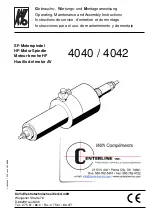
If you see merely one fixed level, either the N4916A or the output of the
Serial BERT is defective.
Check the Output of the N4916A Using the Error Detector
If you have connected the N4916A to a Serial BERT and have no
oscilloscope at hand, you can use the error detector for checking the
output of the N4916A.
1
Set up the pattern generator as described above: Set the Data Offset
to 0 V and the Amplitude to 1 V. Set the De-Emphasis to 6 dB.
2
Press
ED Setup
and open the
Sampling Point Setup
page.
3
Set up the error detector:
– Press the
Edit
button to enter the
ED Input Setup Dialog
.
– Set the
Input
to "Normal".
– Set the
Input Range
to –1 V to +1 V.
– Set the
Threshold
to "Averaging".
– Set the
Termination
to 0 V.
4
Connect the Output of the N4916A to the Data Input of the error
detector.
5
Ensure that the error detector follows the generated pattern.
– Press the
Auto Align
button.
8
Solving Problems
390
Agilent J-BERT N4903 High-Performance Serial BERT
Summary of Contents for J-BERT N4903
Page 1: ...S Agilent J BERT N4903 High Performance Serial BERT User Guide s Agilent Technologies...
Page 68: ...2 Setting up Patterns 68 Agilent J BERT N4903 High Performance Serial BERT...
Page 158: ...4 Setting up the Error Detector 158 Agilent J BERT N4903 High Performance Serial BERT...
Page 314: ...6 Evaluating Results 314 Agilent J BERT N4903 High Performance Serial BERT...
Page 374: ...7 Jitter Tolerance Tests 374 Agilent J BERT N4903 High Performance Serial BERT...
Page 394: ...8 Solving Problems 394 Agilent J BERT N4903 High Performance Serial BERT...
Page 434: ...Index 434 Agilent J BERT N4903 High Performance Serial BERT...
















































